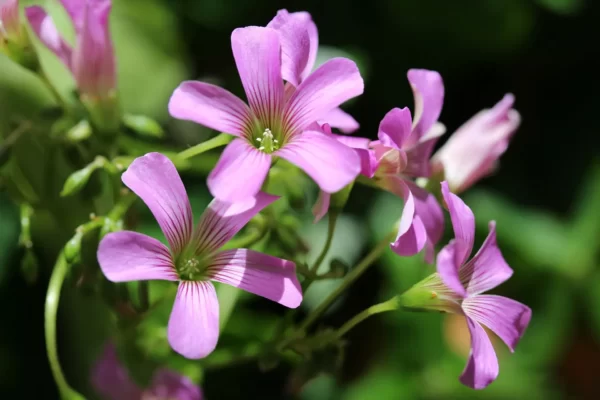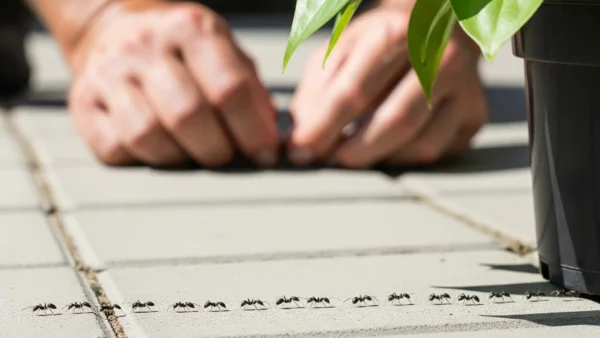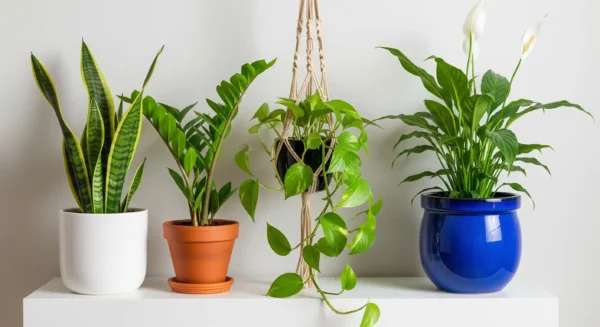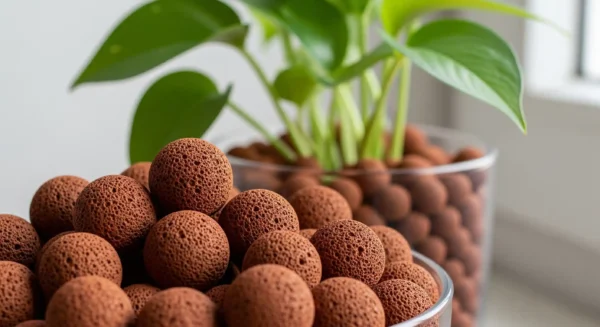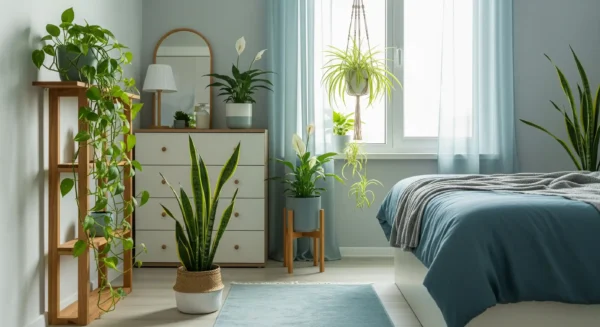Identifying and Fixing Fertilizer Burn. Plant 911! Do You Have Too Much Love for Your Houseplants?
TL;DR: Help! My Plant Might Have Fertilizer Burn!
- What it is: Overfertilizing can “burn” your plant’s roots with excess mineral salts.
- Key Signs: Crispy brown/black leaf tips and edges, wilting even when soil is moist, a white salty crust on the soil or pot.
- Immediate First Aid:
- Stop fertilizing immediately!
- Leach the soil: Slowly flush the pot with plenty of room-temperature water, letting it drain completely. Repeat 2-3 times.
- Be patient: Recovery takes time. Don’t fertilize again for at least 1-2 months, or until you see healthy new growth.
- Prevention is Key: Always dilute fertilizer correctly, only feed actively growing plants (spring/summer), ensure good drainage, and when in doubt, use less.
Greetings, fellow plant lover! Everyone wants their houseplants to thrive, to be lush, colorful, and just full of life, don’t they? And occasionally, in our haste to give them the best possible care, we may be a little—let’s say generous—with the fertilizer. Does that sound familiar? Please know that you’re not the only one nodding along! It’s a very typical situation.
What are the symptoms of fertilizer burn in houseplants and how may it be treated? For your plant’s sensitive roots, overfertilization is essentially a chemical overload that frequently results in apparent distress like telltale burnt leaf tips, wilting even in moist soil, and even a white, crusty accumulation on the soil surface. The good news? This “too much love” problem is often something you can assist your plant recover from. This occurs as a result of the concentrated nutrients harming the roots, which hinders their ability to absorb water, and perhaps causing a poisonous environment in the soil.
Concerned that you may have “over-loved” your green friend by giving them too much plant food? Do not panic! We all have to climb this learning curve. Together, let’s examine the warning indicators and—above all—go over how to put your plant back on track for healing and thriving health.
How Overfertilization Occurs and Why Kindness Can “Kill” at Times
Doesn’t that seem counterintuitive? We’re attempting to nourish our plants in order to help them grow! The problem is that concentrated mineral salts make up fertilizer. In moderation, these nutrients are vital, but in excess, they can cause major issues. Imagine it as if we were taking excessive amounts of vitamins; our bodies would also be unhappy!
So, how usually does this overzealous care occur? The following are a few typical causes of fertilizer burn:
- Overfertilization: This is a major issue. When it comes to plant-based diets, more isn’t necessarily better! There is a limit to how many nutrients plants may use at once.
- Using an overly concentrated solution: If you’re using a liquid fertilizer, it might provide a huge, detrimental shock to the roots if you don’t dilute it correctly as directed on the container.
- Fertilizing dormant plants: In the fall and winter, the majority of houseplants experience a considerable slowdown in growth. If you keep fertilizing them while they’re “sleeping,” the nutrients that aren’t being used simply accumulate in the soil.
- Poor drainage: Water cannot pass through your pot efficiently if the soil is too dense or if the drainage pores are not good. This implies that the fertilizer salts simply build up around the roots because they have nowhere else to go.
- Applying incorrect fertilizer: Certain fertilizers are designed for outside plants and are much too potent for our more sensitive indoor companions.
- The mentality that “if a little is good, a lot is better”: Although it’s a very human thought process, it frequently results in problems when it comes to plants and fertilizer. When I first started growing plants, I was there myself!
In a process akin to reverse osmosis, these salts can actually pull moisture from the plant’s roots when they accumulate in the soil. Even with proper watering, this is what causes that distinctive “burn” and dehydration.
What specifically should you be on the lookout for now that we know how it can occur? When your plant has had too much of a nice thing, it can frequently give you some pretty obvious signs.
How to Tell If Your Houseplants Have Received Too Much Care (Or, More Specifically, Too Little Fertilizer)
Alright, let’s investigate plants. It’s time to pay particular attention to the signs of fertilizer burn if you think your houseplant may have received too much fertilizer. Although your plant is mute, it is undoubtedly communicating through its beauty!
The following are the most noticeable indicators (visual symptoms) to look out for:
- Burnt Leaf Tips and Edges: The first and most traditional symptom is frequently burnt leaf tips and edges. The leaves will have crispy, brown, or occasionally blackened borders and tips. It may begin modestly, but if the problem is not resolved, it may grow. Fertilizer burn is characterized by this.
- Lower Leaf Yellowing or Browning: As the plant tries to deal with the extra salts, the older, lower leaves are frequently impacted first. They may turn brown, then yellow, and finally fall off.
- Wilting Despite Wet Soil: This one can be somewhat perplexing! You inspect the soil because your plant appears thirsty and drooping, and it is moist. What provides? This occurs as a result of the injured roots’ inability to efficiently absorb water, even when it is available.
- Stunted or Slowed New Growth: Overfertilization may be the cause if your plant was developing well and then abruptly slows down, or if new leaves appear small, distorted, or discolored.
- Leaf Drop: Excessive or abrupt leaf loss, particularly if the leaves appeared to be fine just moments before, may indicate concern.
- Symptoms of Root Rot (a possible complication): You may also notice symptoms of root rot if you mix excessive fertilizing with continuously moist soil (perhaps as a result of inadequate drainage or an attempt to “water away” the issue without adequate draining). Affected roots may feel mushy, look brown or black, and occasionally smell bad if you carefully remove the plant from its pot.
Additionally, remember to look for hints in the pot and soil:
- White, Salty Crust on Soil: Have you observed a white, nearly crystalline coating developing on top of the soil? It’s a white, salty crust. There is an obvious accumulation of extra fertilizer salts there.
- Crusty Deposits Around Pot Rims or Drainage Holes: Terracotta pots’ exteriors or the areas surrounding drainage holes may occasionally exhibit such salty residues.
Changes may also be less evident:
- Overall Lack of Vigor: Even if the foregoing signs aren’t immediately apparent, a plant may occasionally just appear “unhappy,” “sickly,” or generally lacking in energy.
Writer’s Tip: Try not to worry too much just yet if you’re noticing any of these symptoms. This article covers the primary indicators, but if you’re not sure, take a few pictures to compare with examples online. Finding the problem is crucial so you can begin to assist your plant.
Fertilizer Burn: Quick Symptom & Action Guide
| Observable Symptom | Likely Fertilizer Burn? | Immediate First Aid Action(s) |
|---|---|---|
| Crispy, brown/black leaf tips & edges | Yes (Classic sign) | Stop fertilizing. Leach soil thoroughly. Optionally remove heavily damaged leaf portions. |
| Wilting, even when soil is moist | Yes (Damaged roots) | Stop fertilizing. Leach soil. Monitor; if no improvement, check roots for rot when repotting might be needed. |
| White, salty crust on soil or pot rim | Yes (Excess salts) | Stop fertilizing. Leach soil. Gently scrape off visible crust from topsoil if significant. |
| New growth is stunted, small, or distorted | Possible | Stop fertilizing. Leach soil. Observe for healthy new growth before considering very diluted feeding later. |
| Sudden or excessive leaf drop | Possible | Stop fertilizing. Leach soil. Rule out other stressors (light, pests, watering changes). |
| Lower leaves yellowing/browning quickly | Often an early indicator | Stop fertilizing. Leach soil. |
Observing any of these indicators? All OK, take a long breath. Damage control is an important next step. Let’s discuss how to prevent this nutrient overload in your plant.
Plant ER: Your Comprehensive Guide to Preserving Your Plant and Reversing Fertilizer Burn
Well, you’ve found the issue; it appears to be fertilizer burn. It’s time for some urgent plant care now! Removing excess salts and allowing the roots of your plant to heal are the objectives here. This is your detailed guide:
Step 1: Quit fertilizing right away!
Although it may seem so simple, this is the first and most important step. Close the bottle of fertilizer! Until your plant has fully recovered, stop feeding it.
Step 2: Evaluate the harm.
Examine your plant carefully. To what extent are the symptoms present? Does the entire plant appear troubled, or are just a few leaves impacted? This will assist you in determining the level of intensity required for your rescue operation.
Step 3: Use the Flushing Method to Leach the Soil.
The foundation for reversing fertilizer burn is this. The excess salts in the soil must be washed away.
- Here’s how: If the weather permits, move your plant—pot and all—to a bathtub, sink, or even the outdoors.
- Pour a generous amount of room-temperature water through the potting mix slowly and gently. Allow water to easily drain from the pot’s bottom drainage holes.
- For a few minutes, keep flushing. You may use twice as much water for a little pot as for a large pot; for larger pots, make sure to flush for a long time.
- After 15 to 30 minutes of letting the pot drain entirely, flush it two or three more times.
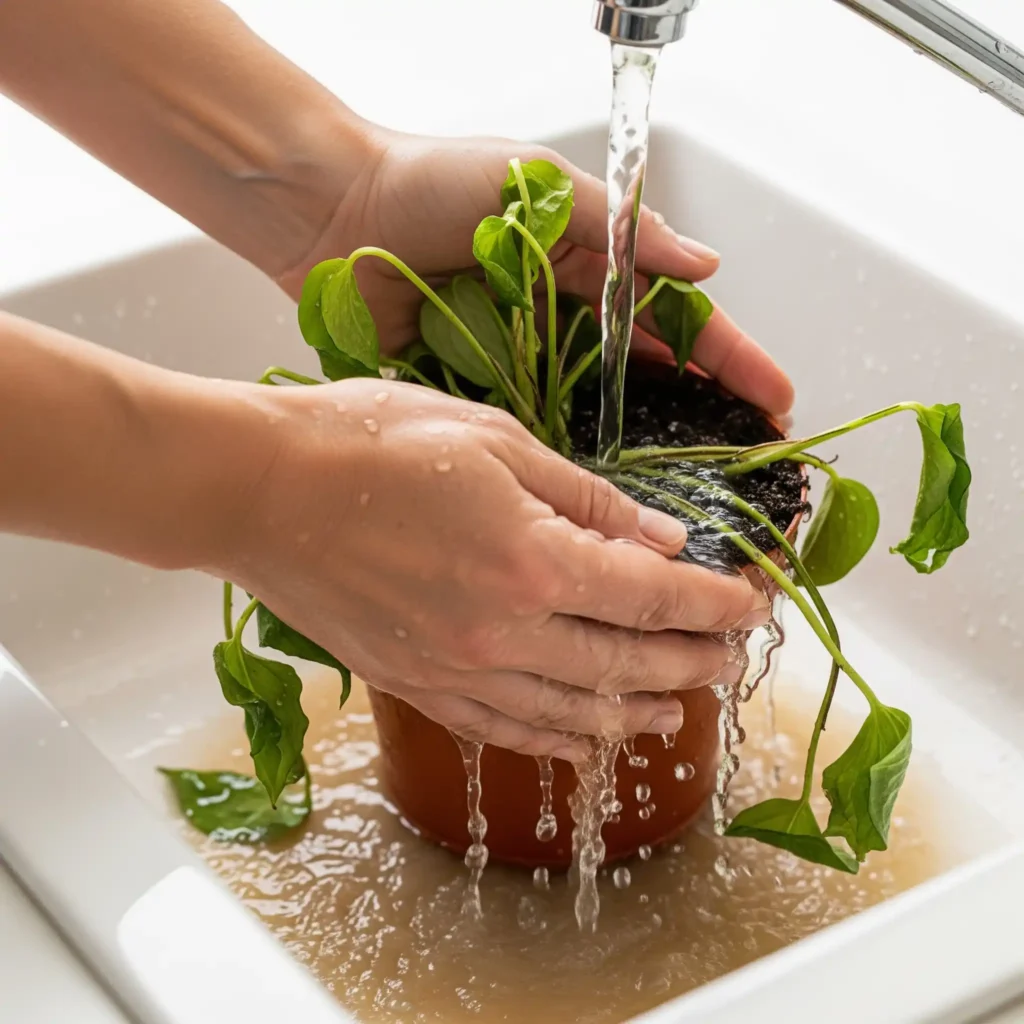
Your Plant Friend’s Story: I understand that doing this can make it seem like you’re nearly drowning your plant, especially if you’re accustomed to watering it carefully! However, thorough flushing is precisely what is required for this emergency surgery in order to remove those dangerous salts.
Step 4: Remove any damaged foliage (recommended but optional).
Unfortunately, those crunchy, highly burned leaves won’t get better.
- Carefully cut off any severely damaged leaves or leaf sections with pruning shears or clean, sharp scissors. In addition to improving the appearance of your plant, this enables it to focus its energy on mending and generating new, healthy growth instead of attempting to maintain damaged areas.
Step 5: If there is severe crusting, remove the top soil.
If the soil’s surface has a noticeable white, salty crust:
- The top inch or two of this contaminated soil should be carefully scraped off. Take care not to harm any roots that are visible.
- Swap it out for brand-new potting mix.
Step 6: Repotting (for severe cases)
Leaching may not always be sufficient, particularly if the burn is severe, the soil is highly contaminated, or you fear root rot has taken hold.
- When is it required? if the roots are obviously harmed (brown, mushy), or if the plant does not appear to be getting better after leaching.
- Method: Carefully take the plant out of its container. Without unduly harming healthy roots, try to shake out as much of the old, contaminated dirt from the root ball as you can. Use sterile scissors to cut off any roots that are obviously dead or rotten. Next, repot the plant using fresh, well-draining potting mix in a clean pot (either the same container, well cleaned, or a new one).
Step 7: Observation and Patience in the Waiting Game.
It takes time to recover from fertilizer burn. Unfortunately, there isn’t a quick solution!
- Following your rescue efforts, relocate your plant to an area that receives the right amount of light for its species (avoid strong, direct sunlight, since this might cause additional stress).
- Water properly, allowing the soil to properly dry out in between applications. Due to the roots’ vulnerability, take additional care not to overwater at this time.
- Importantly, don’t use any fertilizer for a month or two, or longer. Before considering feeding it again, wait until you can clearly see evidence of healthy new development. Then, start with a very diluted solution.
Oh, phew! The difficult part—the emergency intervention—is over. How can we now ensure that this tense circumstance doesn’t recur? Prevention is always the best medicine, as they say.
How to Avoid Overfertilization and Protect Your Flora for the Future
After your plant has recovered (and even for your healthy plants now!), a few easy practices will help maintain your green buddies flourishing and avoid fertilizer burn. My best advice for safely feeding plants is as follows:
- Understanding the needs of your plant is essential. Do some research! While certain plants, like succulents or orchids, have significantly lower nutrition requirements, others, like fast-growing leafy tropicals, are heavier feeders. It’s important to know what your particular plant likes.
- Only fertilize during active growth, which is spring and summer for the majority of houseplants. They can truly use the nutrients you give them when they’re actively growing and putting out new leaves. In the fall and winter, when most plants are dormant or developing extremely slowly, fertilizer should be avoided.
- Adopt the “Less is More” concept: This cannot be overstated! Always err on the side of underfertilization rather than overfertilization when in doubt. If you are a little hungry, your plant will forgive you far more readily than if you burn it.
- Continue to dilute! This is particularly important for fertilizers that are liquid. Always carefully read the label directions and dilute the solution if necessary, especially if your plant is sensitive or you’re just starting out.
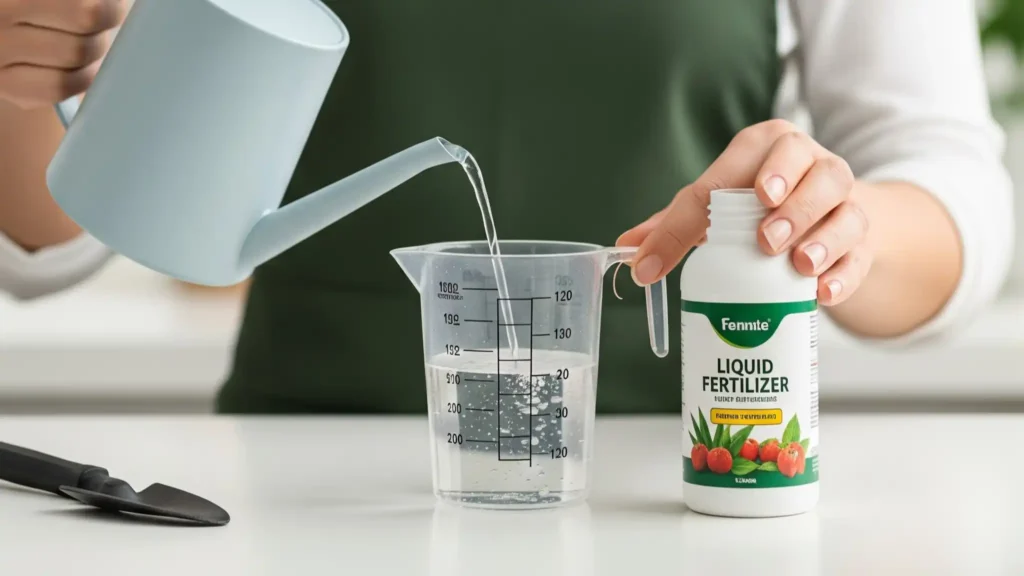
- Select the Proper Fertilizer: Use fertilizers made especially for houseplants. Consider utilizing a slow-release granular fertilizer, which releases nutrients more gradually over time, if you discover that you have trouble with liquid meals.
- Maintain Proper Drainage: This is essential for a number of plant health factors, including avoiding salt accumulation. Always use high-quality, well-draining potting mix and pots with drainage holes.
- Water Well Before Fertilizing: Do you recall the golden rule? The roots are shielded from direct contact with high fertilizer salts by watering them first.
- Think About Periodic Leaching (Preventative Maintenance): Using plain water to gently flush the soil every few months (maybe two or three times a year) is a good idea, even if your plants appear healthy. This keeps mineral salts from gradually accumulating and becoming an issue.
- Regularly Examine Your Plants: Develop the practice of paying close attention to your plants. Take note of their color, rate of growth, and leaf condition. Addressing any early warning signals of disaster is made easier the sooner you notice them.
You’ll be well on your way to establishing a happy, healthy atmosphere where your plants receive the ideal amount of love and nutrition without running the risk of an unintentional overdose if you follow these gentle, thoughtful behaviors. Let’s summarize our learnings from our plant-saving adventure.
In conclusion, the secret to happy houseplants is to nurture them rather than overwhelm them.
Aside from being incredibly fulfilling, caring for houseplants is undoubtedly a learning experience full of small revelations (and perhaps a few “oops” moments!). An essential skill in your plant parent toolbox is knowing how to diagnose and treat fertilizer burn, a symptom of overfertilization in houseplants. We’ve gone over how to identify the issue, take the necessary quick action to save it, and—most importantly—learn how to keep it from happening again. Never forget that the objective is to care for your plants, not to overburden them.
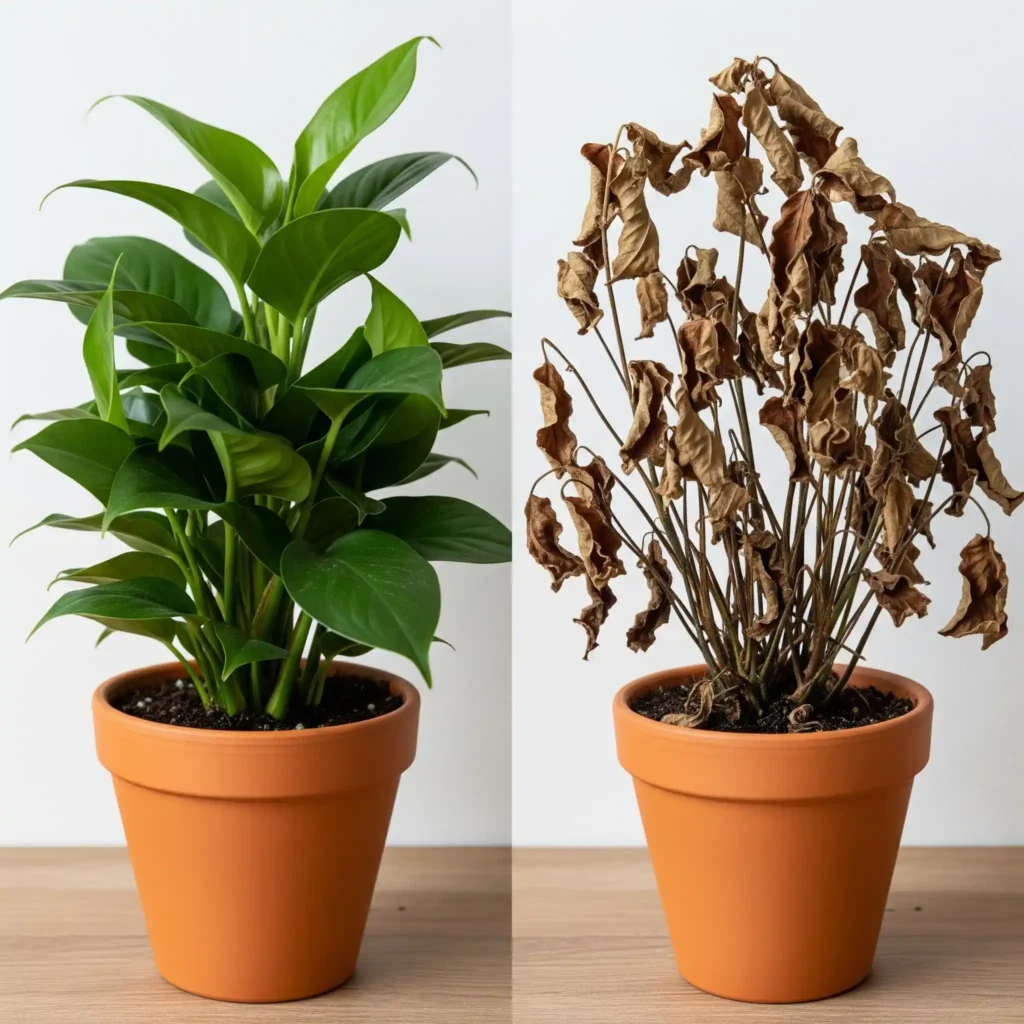
Mindful, perceptive caring is really essential. It’s about realizing that, occasionally, our finest efforts can result in a little too much good. A previous fertilizer mishap shouldn’t deter you! With these tips and a little perseverance, you can now give your green friends the ideal amount of attention, guaranteeing their healthy growth for many years to come. Joyful (and well-rounded) plant-parenting!
Have you ever prevented the dreaded fertilizer burn from killing a plant? Or are there any unanswered questions? Please share your success stories in the comments section below, or let me know how I may be of assistance.




